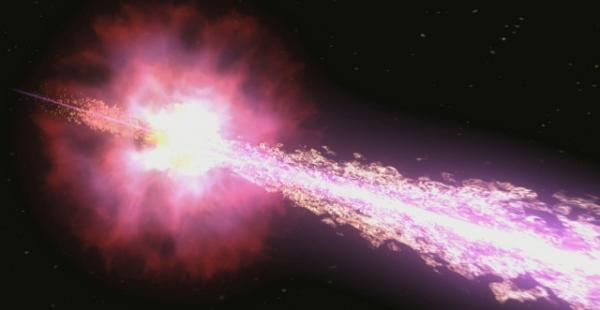
The jet from a powerful gamma-ray burst on March 19 that was bright enough for human eyes to see, despite the distance of 7.5 billion light years, was aimed almost directly at Earth. The burst was observed by satellites and observatories around the world, including ASTRON’s Westerbork Synthesis Radio Telescope. Results of the observation are published today in an article in Nature authored by an international team of 93 astronomers, including Dutch astronomers of the University of Amsterdam, ASTRON, the University of Leiden and the Joint Institute for VLBI in Europe (JIVE).
The explosion, formally known as GRB 080319B, was detected by NASA's Swift satellite on 19 March 2008, which pinpointed its position in the constellation Boötes. Within fifteen seconds the explosion became visible to the human eye. In the article in Nature, the team of astronomers concludes that the burst's extraordinary brightness arose from a jet that shot material directly toward Earth almost at the speed of light.
Observations across the spectrum, from gamma-rays to X-rays, optical, infrared, and radio, began 30 minutes before the explosion and followed its afterglow for months. An international group of astronomers started observing this source with Westerbork as soon as it was visible. Observations started roughly half a day after the burst and the first results were surprising to the community: the source was not detected at radio frequencies in the first observations. ``We were very puzzled by this non-detection, but determined to keep looking for it and suddenly it was clearly there in observations a couple of days later,'' says Alexander van der Horst, a postdoctoral fellow at NASA's Marshall Space Flight Center who led the Westerbork effort. The radio source was gone again a few days after the first detection. According to gamma-ray burst expert Prof. Ralph Wijers from Amsterdam, the Dutch team was completely surprised: ``This unexpected behaviour at radio frequencies puts strong constrains on the possible models to explain this extreme event. It mainly shows there is much more energy in the explosion than just the primarily conspicuous jet. This allows us to survey the magnitude of the area that emits radio waves.''
Gamma-ray bursts are the universe's most luminous explosions. Most occur when massive stars run out of nuclear fuel. As a star's core collapses, it creates a black hole or neutron star that drives powerful gas jets outward. As the jets shoot into space, they strike gas previously shed by the star and heat it, which generates bright afterglows, that can be observed for months on some frequencies.
The author list of the Nature paper consists of several astronomers at institutes in the Netherlands, namely Ralph Wijers, Atish Kamble, and Peter Curran from the University of Amsterdam, Richard Strom from the University of Amsterdam and ASTRON, Mike Garrett from ASTRON and the University of Leiden, and Zsolt Paragi from JIVE.
The Westerbork Synthesis Radio Telescope is operated by ASTRON (Netherlands Institute for Radio Astronomy), an institute of the Netherlands Organisation for Scientific Research (NWO).
More images can be found on http://www.nasa.gov/mission_pages/swift/bursts/naked_eye_telecon.html.
